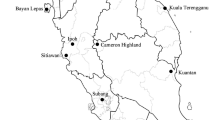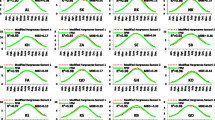Abstract
Evapotranspiration is one of the most important elements for quantifying available water since it generally constitutes the largest component of the terrestrial water cycle. This study evaluated four models (Makkink, Turc, Priestley–Taylor and Hargreaves) commonly used to estimate monthly reference crop evapotranspiration (ETo) values. The main aim of this study was to determine the model used to estimate ETo with small data requirements and high accuracy for twelve synoptic stations in four climates of Iran. The results showed that the Turc model was the best suited model in estimating ETo for cold humid and arid climates. The Hargreaves model turned out to be the most precise model under warm humid and semi-arid climatic conditions. In contrast, the Makkink model presented the poorest estimates in all of the climates exception for cold humid environment. In cold humid climate, the Hargreaves model was the least accurate model in estimating ETo. In general, the results obtained from this study revealed very clearly that the Makkink and Priestley–Taylor models estimated ETo values less accurately than Turc and Hargreaves models for the all climates.
Similar content being viewed by others
References
Allen RG (2003) REF-ET user’s guide. University of Idaho Kimberly Research Stations, Kimberly
Allen RG, Periera LS, Raes D, Smith M (1998) Crop evapotranspiration: guideline for computing crop water requirement. FAO Irrigation and Drainage Paper No. 56. Food and Agriculture Organization of the UN, Rome, Italy, p 301
Amatya DM, Skaggs RW, Gregory JD (1995) Comparison of methods for estimating REF-ET. J Irrig Drain Eng 121(6):427–435
Anyadike RNC (1987) The Lincare evaporation formula tested and compared to others in various climates over West Africa. Agric For Meteorol 39(2–3):111–119
Barnett N, Madramootoo CA, Perrone J (1998) Performance of some evapotranspiration equations at a site in Quebec. Can Agric Eng 40(2):89–95
Behnke JJ, Maxey GB (1969) An empirical method for estimating monthly potential evapotranspiration in Nevada. J Hydrol 8:418–430
Blaney HF, Criddle WD (1950) Determining water requirements in irrigated areas from climatological and irrigation data. Soil Conservation Service Technical Paper 96, Soil Conservation Service. U.S. Dept. of Agriculture, Washington
Chuanyan Z, Zhongren N, Zhaodong F (2004) GIS-assisted spatially distributed modeling of the potential evapotranspiration in semi-arid climate of the Chinese Loess Plateau. J Arid Environ 58:387–403
Dingman SL (1994) Physical Hydrology, Upper Saddle River. Prentice Hall, Upper Saddle River
Droogers P, Allen RG (2002) Estimating reference evapotranspiration under inaccurate data conditions. J Irrig Drain Sys 16:33–45
Fontenot RL (2004) An evaluation of reference evapotranspiration modeols in Louisiana. M.Sc. Thesis, B.S., Louisiana State University and A&M College
George BA, Reddy BRS, Raghuwanshi NS, Wallender WW (2002) Decision support system for estimating reference evapotranspiration. J Irrig Drain Eng 128(1):1–10
Hansen VE, Israelsen OW, Stringham GE (1980) Irrigation principles and practices, 4th edn. Wiley, New York
Hargreaves GH, Samani ZA (1985) Reference crop evapotranspiration from temperature. Appl Eng Agric 1(2):96–99
Hargreaves GH, Allen RG (2003) History and evaluation of Hargreaves evapotranspiration equation. J Irrig Drain Eng 129(1):53–63
Hargreaves LG, Hargreaves GH, Riley JP (1985) Irrigation water requirements for Senegal river basin. J Irrig Drain Eng 111(3):265–275
IRIMO (2007) Iranian meteorological office, data processing center. Tehran, Iran
Irmak S, Allen RG, Whitty EB (2003) Daily grass and alfalfa-reference evapotranspiration estimates and alfalfa-to-grass evapotranspiration ratios in Florida. J Irrig Drain Eng 129(5):360–370
Jensen ME, Haise HR (1963) Estimating evapotranspiration from solar radiation. J Irrig Drain Div 93(IR3):15–41
Jensen ME, Burman RD, Allen RG (1990) Evapotranspiration and irrigation water requirements. ASCE Manual 70:332–333
Jensen DT, Hargreaves GH, Temesgen B, Allen RG (1997) Computation of ETo under nonideal conditions. J Irrig Drain Eng 123(5):394–400
Kashyap PS, Panda RK (2001) Evaluation of evapotranspiration estimation methods and development of crop-coefficients for potato crop in sub-humid region. Agric Water Manag 50:9–25
Landeras G, Ortiz-Barredo A, López JJ (2008) Comparison of artificial neural network models and empirical and semi-empirical equations for daily reference evapotranspiration estimation in the Basque Country (Northern Spain). Agric Water Manag 95:553–565
Lopez-Urrea R, Mart\(\imath \)n de Santa Olalla F, Fabeiro C, Moratalla A (2006) Testing evapotranspiration equations using lysimeter observations in a semiarid climate. Agric Water Manag 85:15–26
Makkink GF (1957) Testing the Penman formula by means of lysimeters. J Inst Water Eng 11(3):277–288
Nandagiri L, Kovoor GM (2006) Performance evaluation of reference evapotranspiration equation across a range on Indian climate. J Irrig Drain Eng 132(3):238–249
Penman HL (1948) Natural evaporation from open water, bare soil, and grass. Proc R Soc Lond A193:120–146
Priestley CHB, Taylor RJ (1972) On the assessment of surface heat flux and evaporation using large scale parameters. Mon Weather Rev 100:81–92
Qiu GY, Miyamoto K, Sase S, Gao Y, Shi P, Yano T (2002) Comparison of the three-temperature model and conventional models for estimating transpiration. JPN Agric Res Quart 36(2):73–82
Sabziparvar AA, Tabari H, Aeini A, Ghafouri M (2009) Evaluation of class A pan coefficient models for estimation of reference crop evapotranspiration in cold-semi arid and warm arid climates. Water Resour Manag. doi:10.1007/s11269-009-9478-2
Salih AMA, Sendil U (1983) Evapotranspiration under extremely arid environment. J Irrig Drain Eng 110(3):289–303
Sumner DM, Jacobs JM (2005) Utility of Penman–Monteith, Priestley–Taylor, reference evapotranspiration, and pan evaporation methods to estimate pasture evapotranspiration. J Hydrol 308:81–104
Temesgen B, Allen RG, Jensen DT (1999) Adjusting temperature parameters to reflect well-watered conditions. J Irrig Drain Eng 125(1):26–33
Thornthwaite CW (1948) An approach toward a rational classification of climate. Georaph Rev 38:55–94. doi:10.2307/210739
Trajkovic S, Kolakovic S (2009) Evaluation of reference evapotranspiration equations under humid conditions. Water Resour Manag 23:3057–3067
Turc L (1961) Evaluation des besoins en eau d’irrigation, evapotranspiration potentielle, formule climatique simplifee et mise a jour. Annal Agron 12(1):13–49 (in French)
Xu CY, Singh VP (2002) Cross comparison of empirical equations for calculating potential evapotranspiration with data from Switzerland. Water Resour Manag 16(3):197–219
Author information
Authors and Affiliations
Corresponding author
Rights and permissions
About this article
Cite this article
Tabari, H. Evaluation of Reference Crop Evapotranspiration Equations in Various Climates. Water Resour Manage 24, 2311–2337 (2010). https://doi.org/10.1007/s11269-009-9553-8
Received:
Accepted:
Published:
Issue Date:
DOI: https://doi.org/10.1007/s11269-009-9553-8




